as with other long posts/stories, today the photos come first.
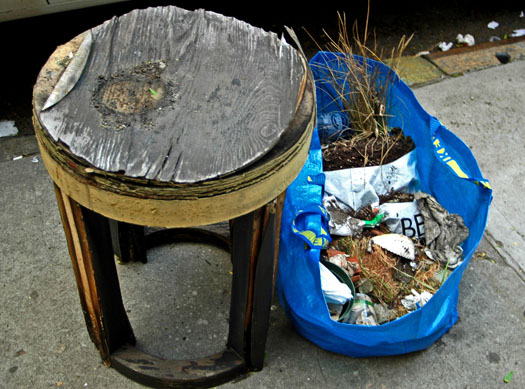
the times they have a'changed

Memorial Day 1991 was a major turning point in the struggle for the soul of the Lower East Side. The riot that erupted in Tompkins Square was used to publicly justify a plan already in the works to alter the park and neighborhood.
It became obvious pretty fast that we had fallen for a provocation; that we had played into the hands of the enemy. We gave the City exactly what it wanted.
Now, keep in mind that at that point, riots in Tompkins Square were more a ritual of summer than a rare event -- starting with the infamous 1988 Police Riot. The stakes were high; a lot of powerful people had a lot of money and future political power riding on the economic shift and wave of displacement of long time residents known as gentrification.
The park was the center of activity for those that opposed these changes. The bandshell in the park was rumored to have been built after some racial hostilities in the 60s. The idea, the rumor says, was that by allowing all parts of the community to easily put on concerts, performances and protests those different parts of the community would learn more about each other and possibly even interact and find common ground.
From what I could tell it worked. However, much to the dismay of the powers that be, it worked too well. The different factions and segments of the neighborhood started to realize that not only did they have common ground, but they also had a common enemy.
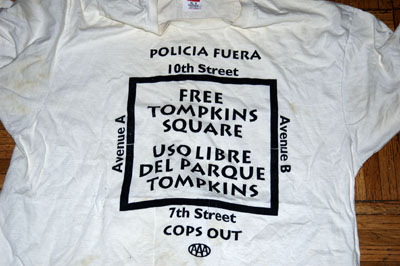 The park had to be "cleaned up" and closed at night. The bandshell needed to disappear. The City still had a bit of a black eye in terms of how the public viewed the situation around the park. The revelations that followed the '88 Police Riot still lingered in public memory.
The park had to be "cleaned up" and closed at night. The bandshell needed to disappear. The City still had a bit of a black eye in terms of how the public viewed the situation around the park. The revelations that followed the '88 Police Riot still lingered in public memory.
If the City could win back the narrative; if they could regain the moral high ground, the plans could move forward.
Contracts to build a 10 foot fence around the park had already been signed; plans to demolish the bandshell already in place -- all they needed was a pretense.
I was at a meeting of the anarchist affinity group I'd been participating in for a while. It was like a scene from Monty Pytyon's "Life of Brian." The People's Front is meeting and someone comes in to tell them that the revolution is happening NOW. Their reaction... "ok, new agenda..."
OK, that's not exactly how it went, but we were meeting at the apartment I shared with my girlfriend and another friend when one of the affinity group members came in and told us that the concert in the park looked like it was developing into a bit of a riot. We all headed out into the streets; the park was only two blocks away.
The rumor -- to this day I do not know if it was true or not -- was that the cops started harassing a homeless man and he decided that with all those anarchists, squatters, housing activists and homeless advocates in the park that he had no reason to take their crap. One thing led to another and soon the bottles were flying and the back and forth surge of cops in one direction and then bottles and activists pushing them back started.
The cops retreated; fires were built; trash cans were overturned and makeshift barricades went up.
The cops went around to all the stores and restaurants still open and warned them that they should shut down. I'll never forget Ray, the guy that owns the small news stand/soda shop on Ave A. just north of 7th street. When he was told to close, he told the cops that the activists were his customers and as long as we were in the street he'd stay open.
There was a strange mood in the air. At one point, someone that none of the neighborhood activists recognized came out of the crowd. Only a few people thought it was strange that he had a crowbar, only a few objected when he broke the locks off the health and beauty aids store north of Ray's.
The gate rolled up and a mob ransacked the place. Even if we won the battle of that night, we had just lost the war.
Eventually a torrential downpour started, the fires went out and everyone ran for shelter.
Public opinion anywhere but in the neighborhood was turned against us. A couple weeks later the park was closed; the fence built; the bandshell destroyed; 14 months of police occupation had begun.
One night after the closing of the park, during a protest a limousine nearly ran down half the crowd. These days, a limo on Ave C and 7th street could be a tourist partying at one of the million hip bars or nightclubs; even someone who lives in the vicinity. Those days, especially on that corner, it meant one thing: some rich jackass buying heroin. The driver of the limo freaked out, and with hundreds of people on either side of the car marching down the street, drove through the crowd. No one was hurt but a lot of people were angry. In a frantic move to get away from the angry crowd, the driver turned down 5th street.
Anyone familiar with the neighborhood would have known to not make that mistake. 5th between C and B is a dead end. The driver stops at the end of the street, thinks for a minute and then turns around, sees the angry crowd and floors it. Luckily we all got out of the way and no one was killed.
There are two details about this event that stick with me. The license plate of that limo (New Jersey, OL519C) and the way the NY Times mentioned this part of the protest under the subhead "Bad Relations With Neighbors" telling the story, without anything but the reporter's outsider assumptions, of how the protest attacked a neighbor, in his car on his way home.
Even among most of the staff of the radical weekly newspaper I worked for at the time, The Guardian Newsweekly, the view of the story followed the official narrative. Not only did I sense a disrespect of this movement but the story was never covered in depth in the paper.
One staff member even referred to that report as she told me of how the demonstrations and activists, who she believed to be crazed anarchists, acted without respect for the people that lived in the neighborhood. When it came to coverage of foreign issues, she knew not to trust the Times, but when it came to issues in her own city she trusted the Times more than the members of the staff that had seen the protests with their own eyes.
Some good came out of this. Alliances were strengthened among many factions in the neighborhood. Anarchists stood side by side with church parishioners, priests, immigrants, artists and even a few yuppies in an event called "hands around the park."
A nightly ritual that became known as "walking the pig" started the day after the park was closed and continued nightly for at least a month. We'd walk around the neighborhood chanting and singing -- a crowd of up to a couple thousand people, followed by hundreds of well armed riot cops.
Those alliances continue to today, but much of what we were fighting for has been lost.
So, on this memorial day, I sat back in the park and remembered some of my comrades in struggle that are no longer with us. Uncle Donie, Presente! Lisa, Presente! Brad, Presente!, Michael, Presente! I remain inspired by your spirits.




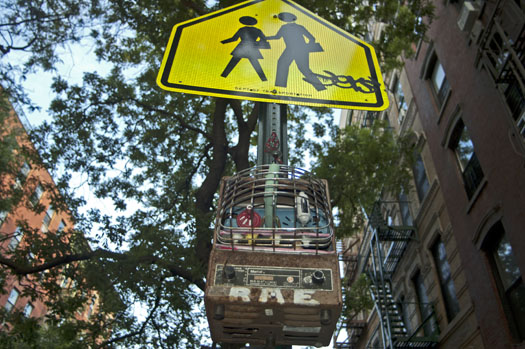
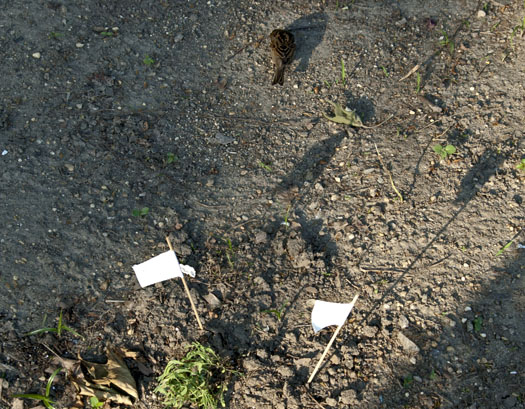
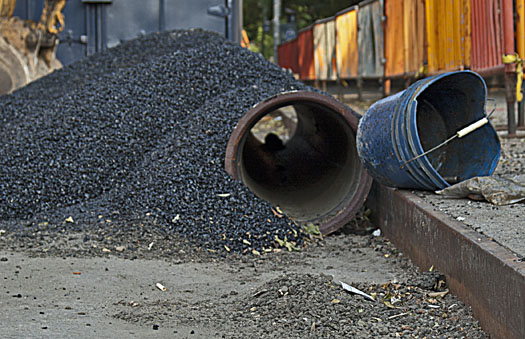
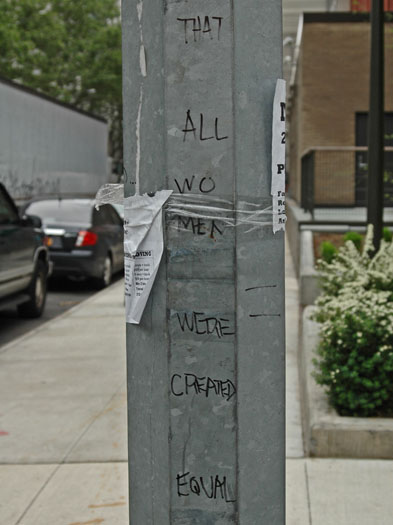
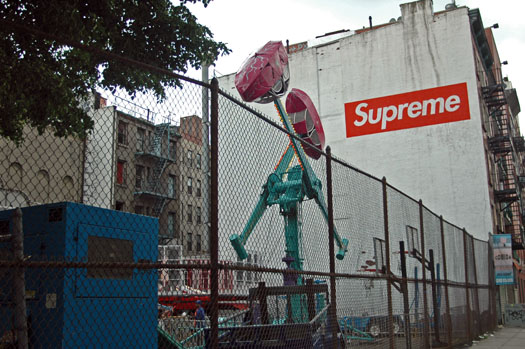


Recent comments
12 years 30 weeks ago
13 years 26 weeks ago
13 years 27 weeks ago
13 years 27 weeks ago
13 years 36 weeks ago
13 years 36 weeks ago
13 years 36 weeks ago
13 years 36 weeks ago
13 years 36 weeks ago
13 years 48 weeks ago